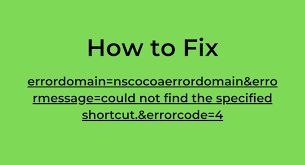Understanding the Error: errordomain=nscocoaerrordomain&errormessage=could not find the specified shortcut.&errorcode=4
In today’s digital world, technical errors can appear at any moment. One such puzzling issue some users may see is the message: errordomain=nscocoaerrordomain&errormessage=could not find the specified shortcut.&errorcode=4
This error can confuse both new and experienced users, especially when working on Apple devices or within certain apps. This blog post is dedicated to explaining this error, what it means, why it happens, and how to fix it step by step in a way that anyone can follow.
What Does This Error Mean?
Let’s break down the error phrase to understand it better:
- ErrorDomain=NSCocoaErrorDomain: This tells us that the error belongs to Apple’s Cocoa framework. Cocoa is the backbone of many apps on macOS and iOS.
- ErrorMessage=Could not find the specified shortcut: This part says the system or app tried to locate a shortcut (probably a file or command link), but it wasn’t found.
- ErrorCode=4: This numeric code represents a specific kind of problem, typically tied to missing files or unavailable paths.
In plain terms, the system expected to find something (usually a shortcut, alias, or symbolic link), but it was either deleted, moved, or never created properly.
When Does This Error Appear?
Although this error might pop up in different situations, here are the most common triggers:
- Opening an app that depends on a shortcut or alias
- Using a script or automation tool that refers to a missing file
- Attempting to load a configuration or project that expects certain items in exact places
- Trying to restore something from backup, but not all paths are available
Step-by-Step Guide to Fix
errordomain=nscocoaerrordomain&errormessage=could not find the specified shortcut.&errorcode=4This section provides a set of easy-to-follow steps you can take to fix the issue.
Step 1: Understand What Shortcut is Missing
The first and most important task is identifying what shortcut or alias is not being found.
- Think about what you were doing when the error appeared
- Check logs or messages if the app provides them
- Look for filenames, paths, or hints
If you recently deleted or renamed something, you may already know the cause.
Step 2: Use Finder or File Explorer to Check the Expected Location
Often, this issue happens because the shortcut (also known as an alias on Mac) no longer exists at the place where the app or system expects it to be.
- Navigate to the directory mentioned or implied in the error
- If you don’t know the path, try searching for the name of the missing shortcut
Once you find it’s not there, the system is correctly reporting its absence.
Step 3: Recreate the Missing Shortcut or Alias
If you understand what file or folder is missing, and you still have the original source, recreate the shortcut or alias:
- Locate the original file
- Right-click (or Control-click) on it
- Select “Make Alias” or “Create Shortcut”
- Place the new alias in the location where the original was expected
This step often resolves the problem immediately.
Step 4: Repair Permissions or Reset File Access
Sometimes, even when the file is in place, the system might not recognize it due to file permission issues.
To fix this:
- Go to System Settings > Privacy & Security
- Under Full Disk Access, make sure the app has permission
- You can also right-click the folder and choose “Get Info” to adjust read/write permissions
After fixing permissions, restart the app or system and check if the error goes away.
Step 5: Check for Typos or Incorrect Paths in Scripts
If you’re using an automation script, shell command, or app that refers to a specific file, open the script and look closely:
- Ensure the file name is typed correctly
- Make sure the full path to the file exists
- Check that directories have not been renamed
Even a small mistake in the name or folder path can lead to this error.
Step 6: Restore from Backup (If Applicable)
If you recently deleted something important and can’t recreate it, try restoring it from a backup:
- Use Time Machine or any backup software you use
- Navigate to the last known working backup
- Restore the missing shortcut or file to its original location
Step 7: Reinstall the App or Tool That Threw the Error
If nothing else works, the app that triggered the error might be misconfigured or corrupted. Reinstalling can often resolve hidden issues:
- Delete the app (but keep its data if you want)
- Download a fresh copy from the official site or App Store
- Install again and set up from scratch or import your old settings
How to Prevent This Error in the Future
Prevention is always better than repair. Here are some habits to avoid seeing this type of error again:
- Avoid moving or renaming files used by apps
- Keep aliases and shortcuts clearly labeled
- Use folders with consistent paths
- Back up your system regularly
- Don’t delete unknown files unless you’re sure
By organizing files carefully and avoiding unnecessary changes, you reduce the chance of broken links or missing items.
Advanced Tip: Use Terminal to Troubleshoot
If you’re comfortable with Terminal (the command line on macOS), you can use it to verify the presence of shortcuts or symbolic links:If you see a “No such file or directory” message, it confirms the file is missing. You can also use ln -s to create a new symbolic link.
Common Scenarios Where This Error Can Occur
Let’s look at a few situations where this error is known to appear:
- Xcode Projects: If your Xcode project expects a file or folder that’s been removed, you may see this message.
- Scripted Apps: Apps built with scripting tools like Automator or AppleScript may refer to aliases that no longer exist.
- Custom Shortcuts: Users often create custom app or folder shortcuts for faster access, and when these are deleted or moved, apps relying on them will fail.




